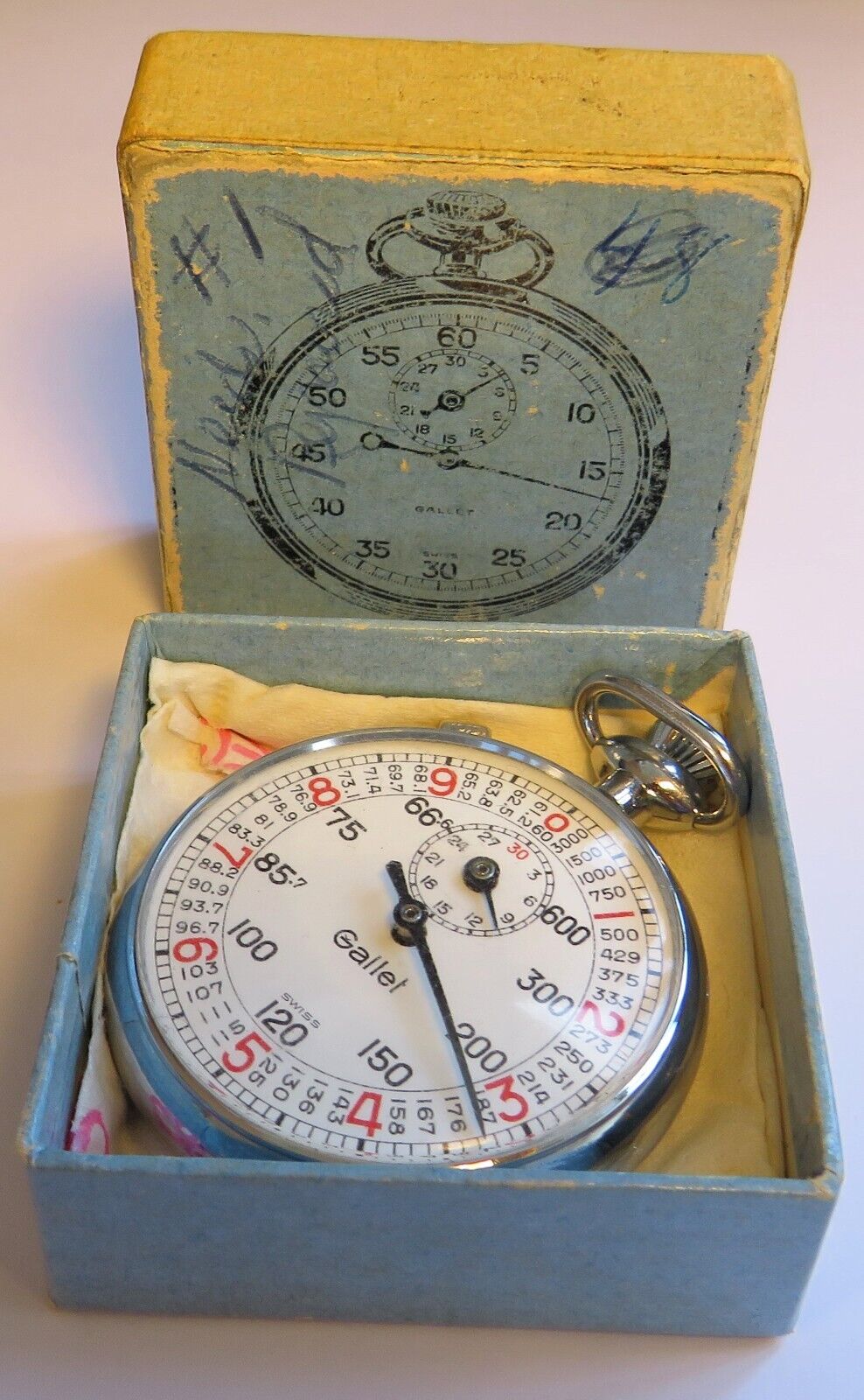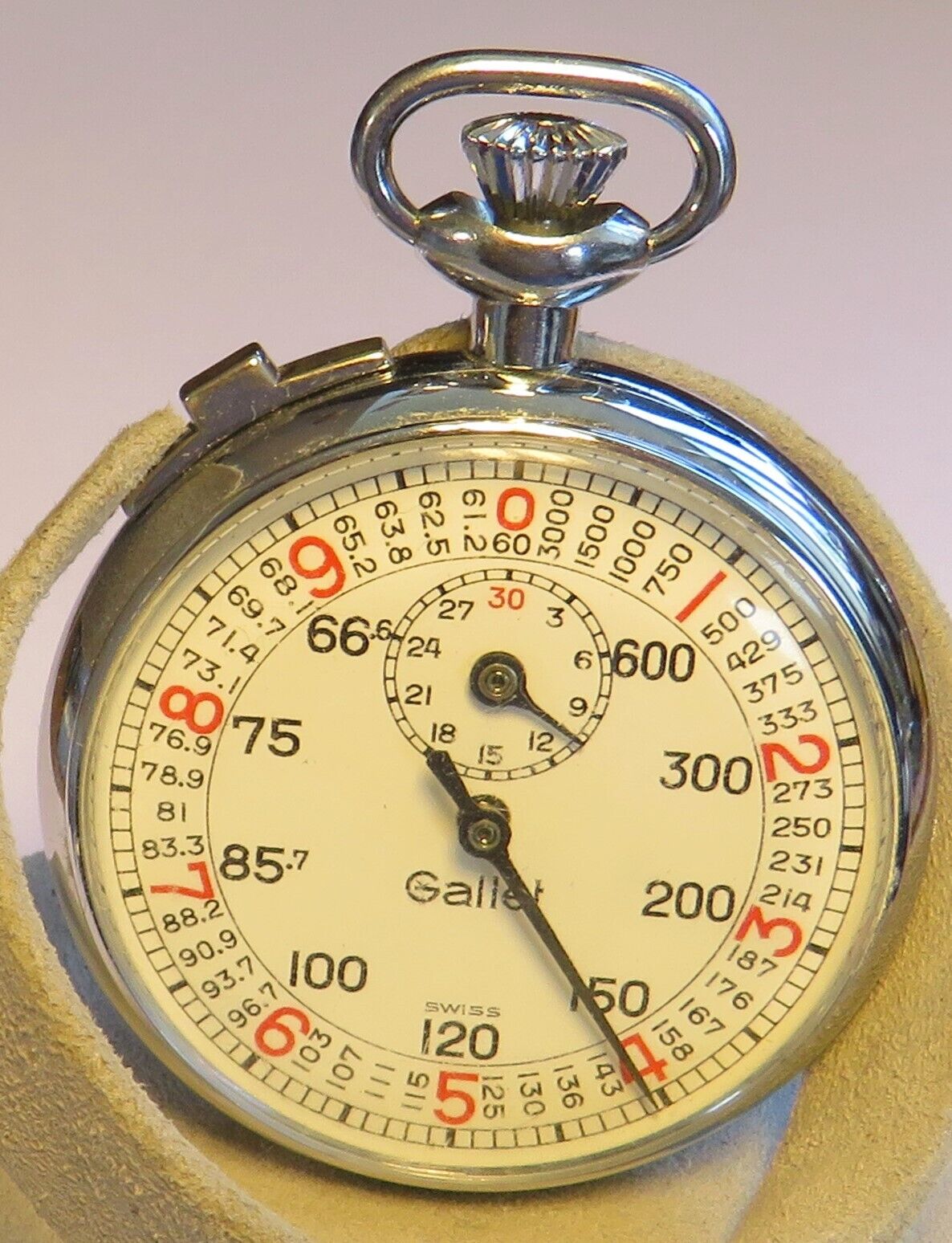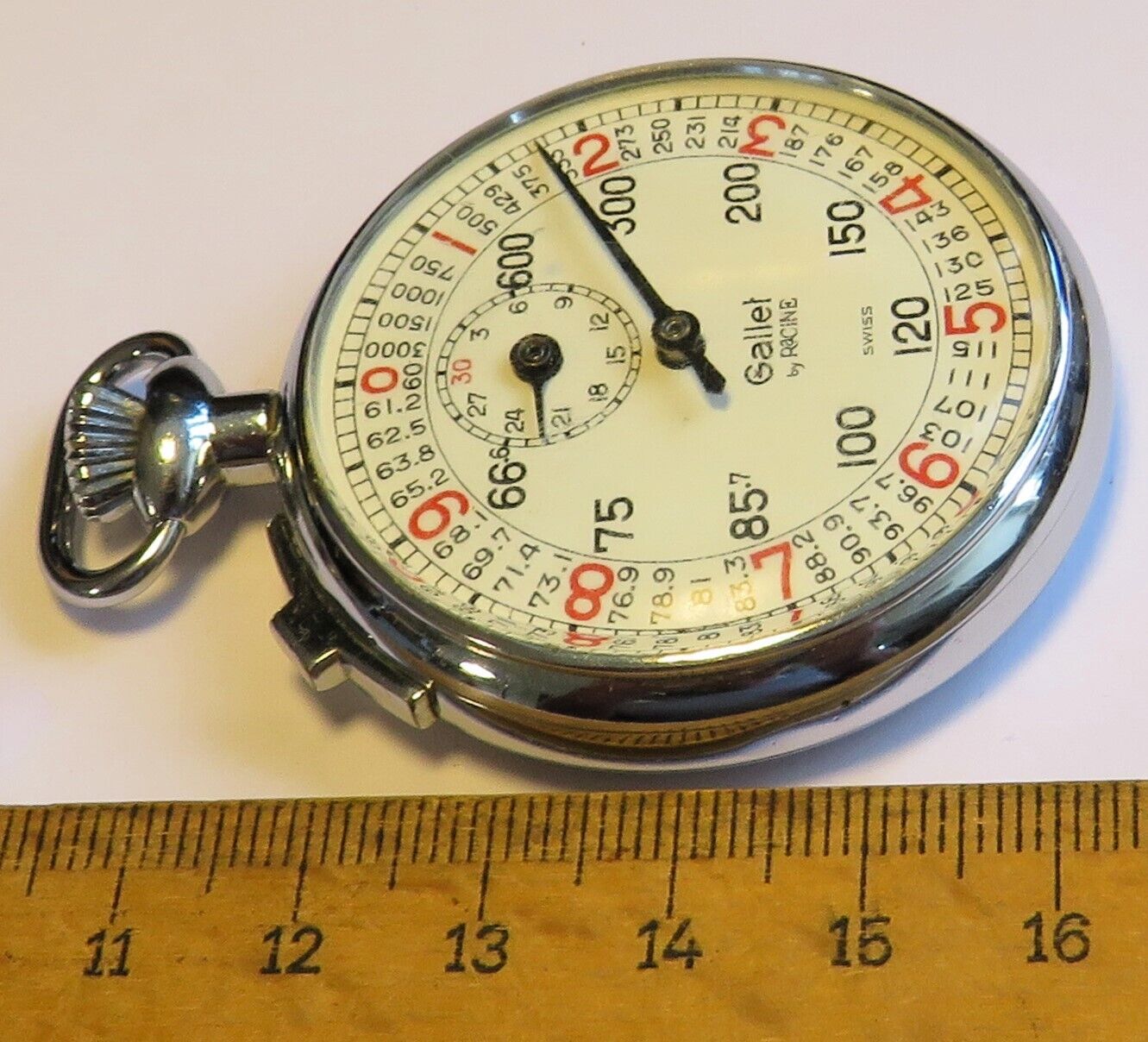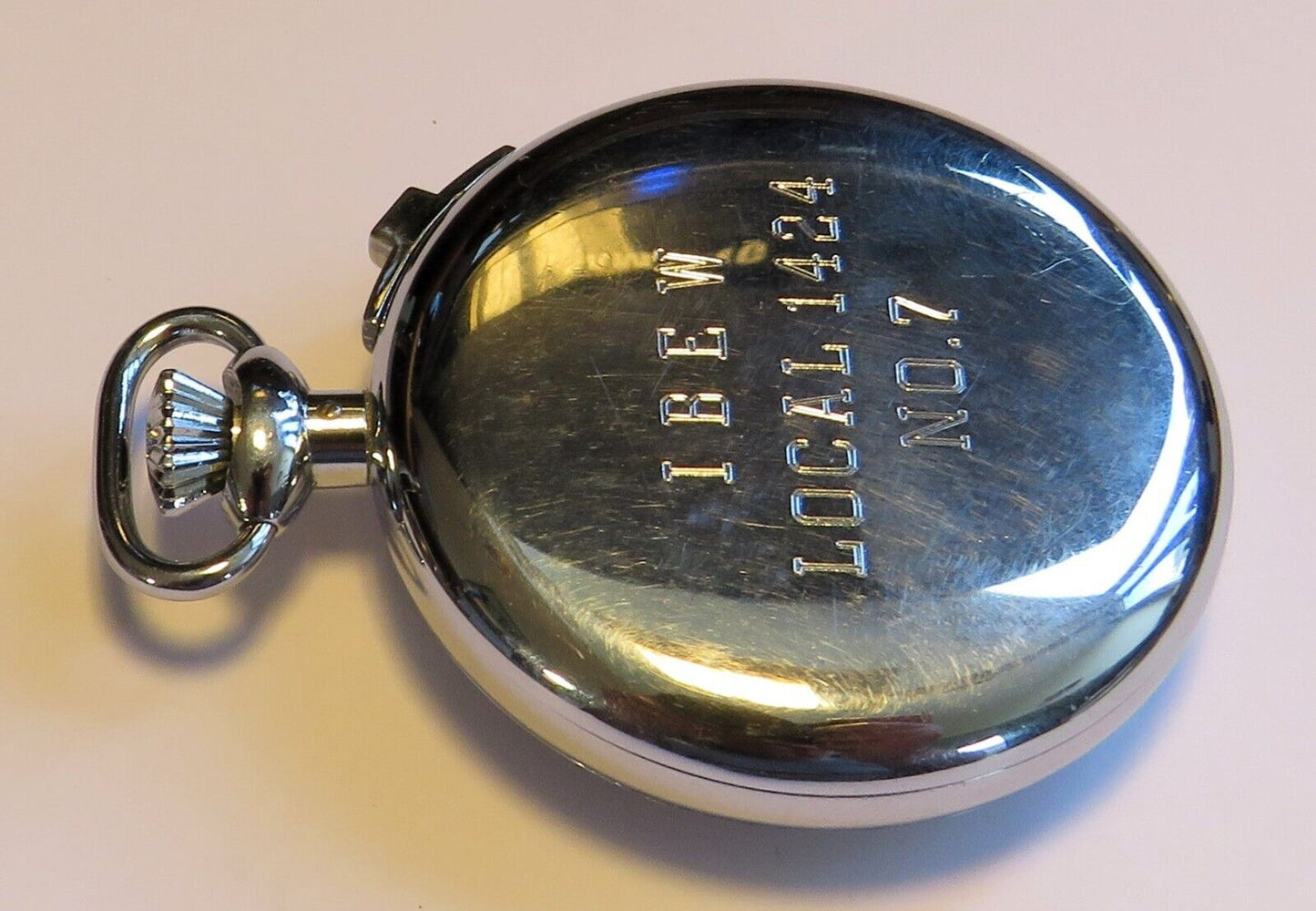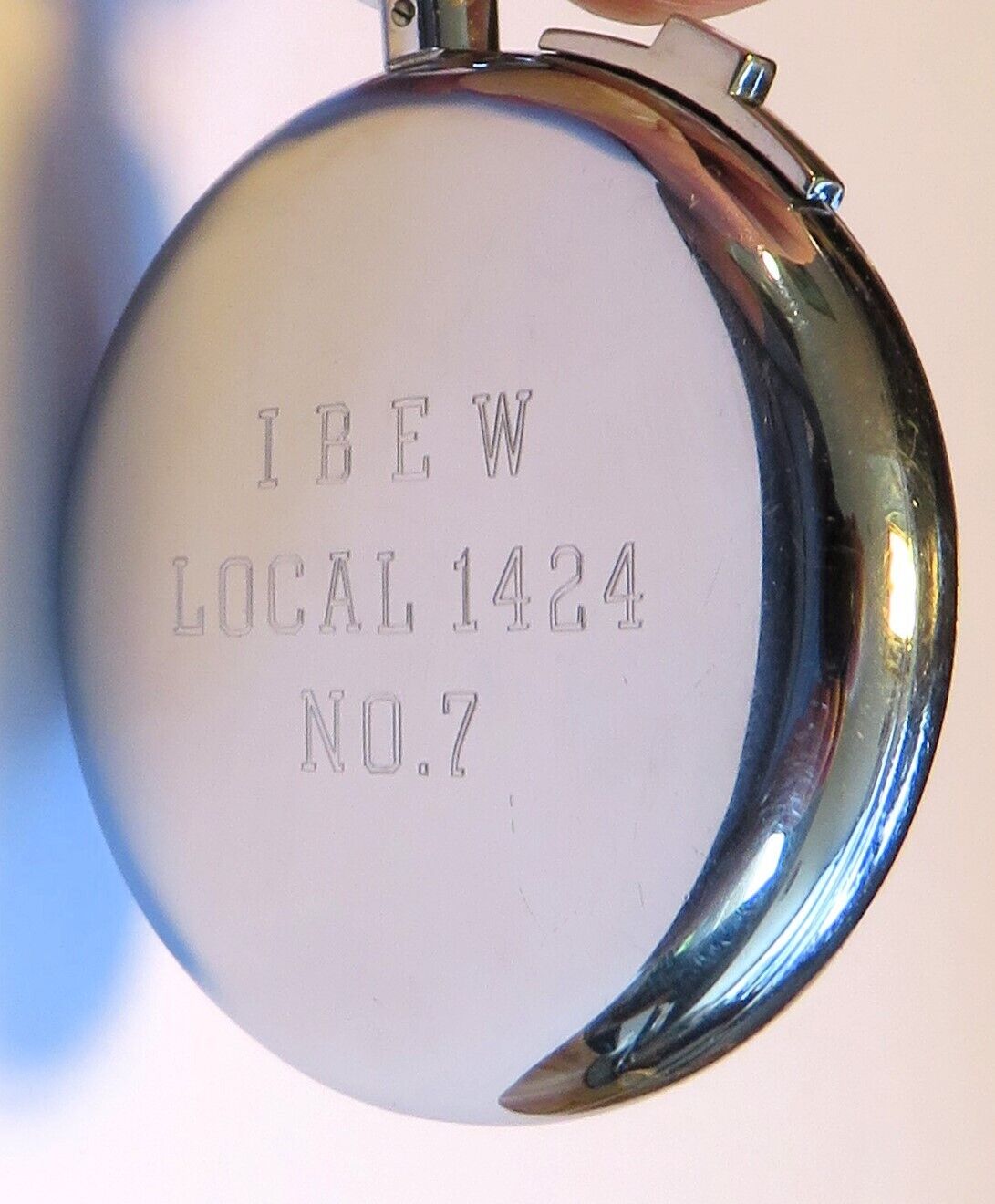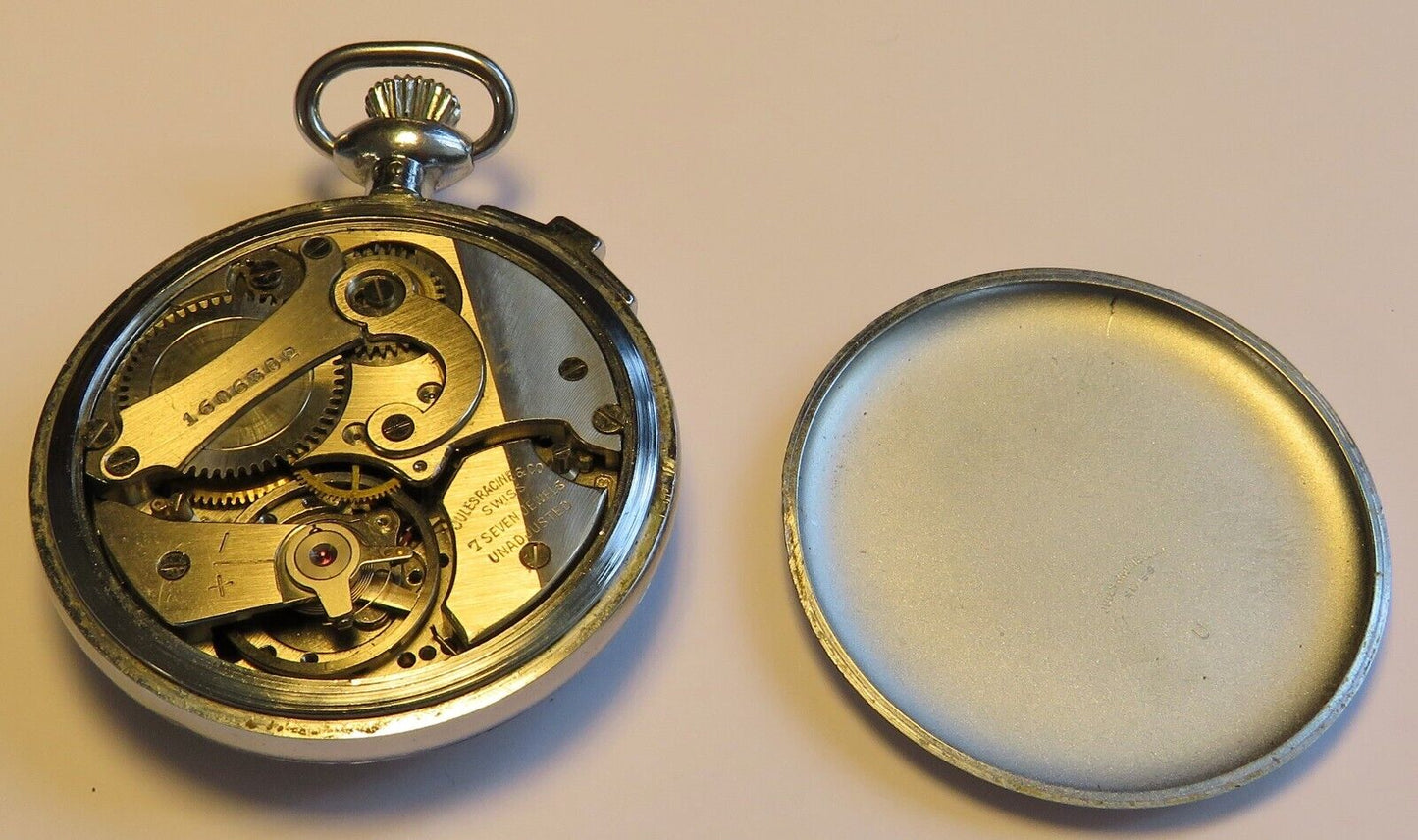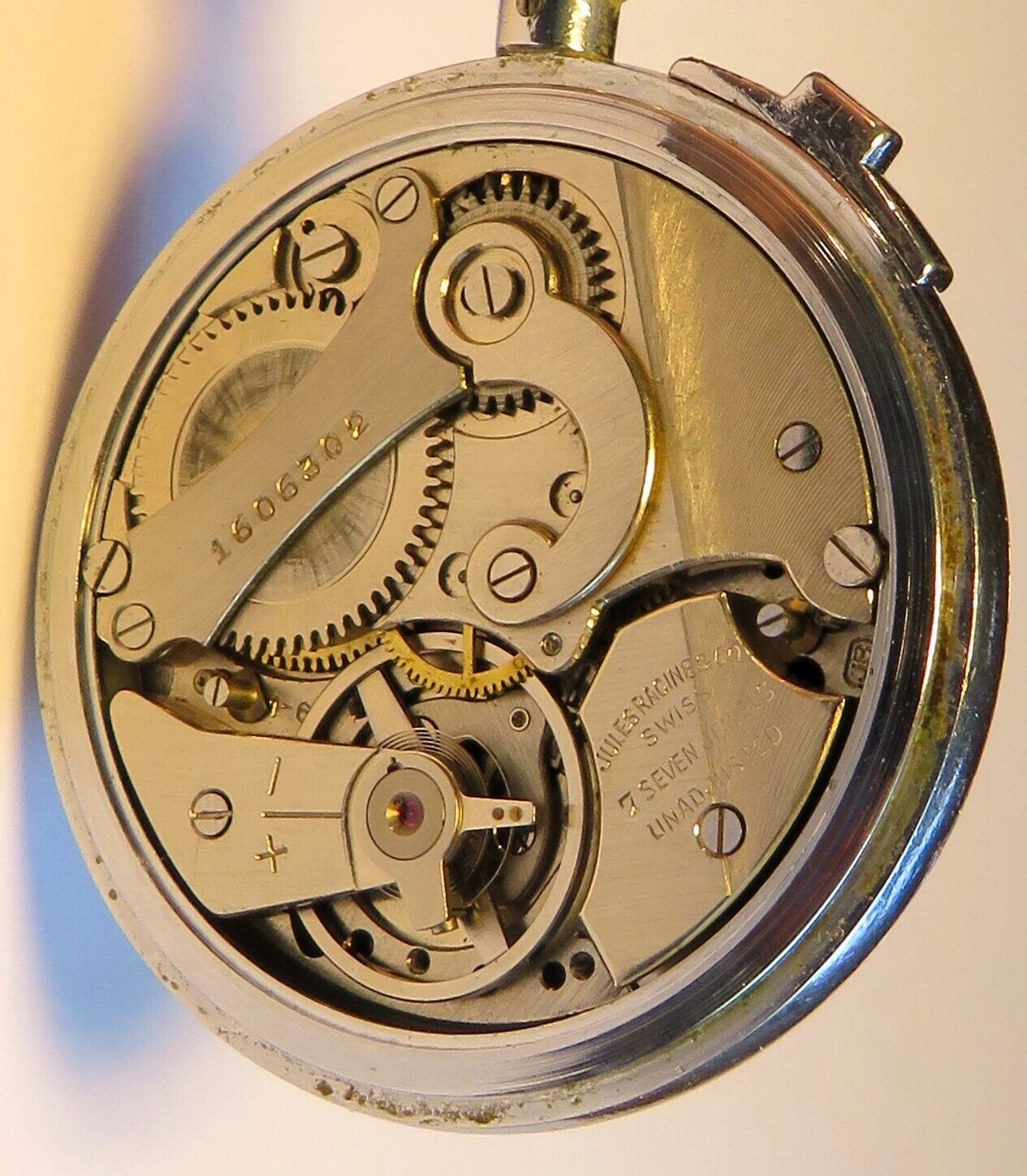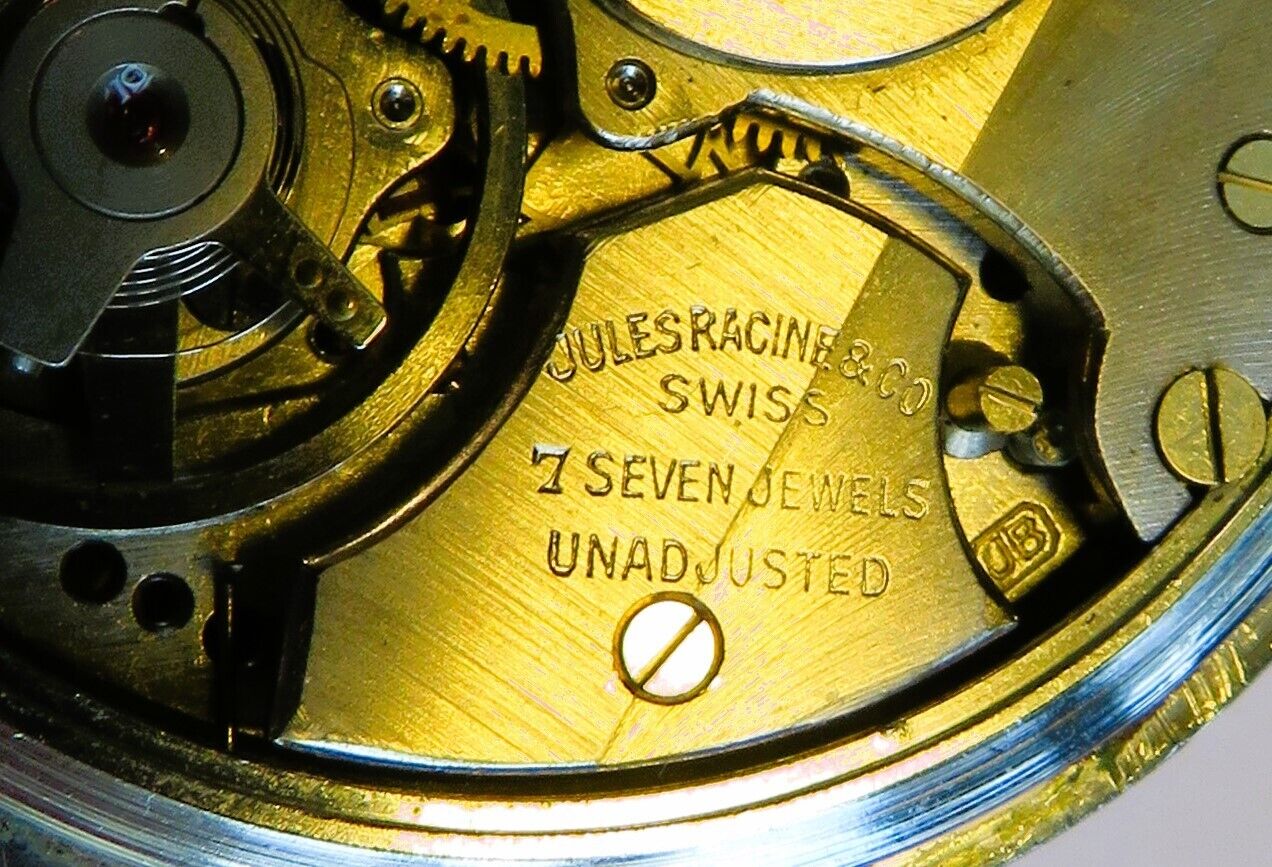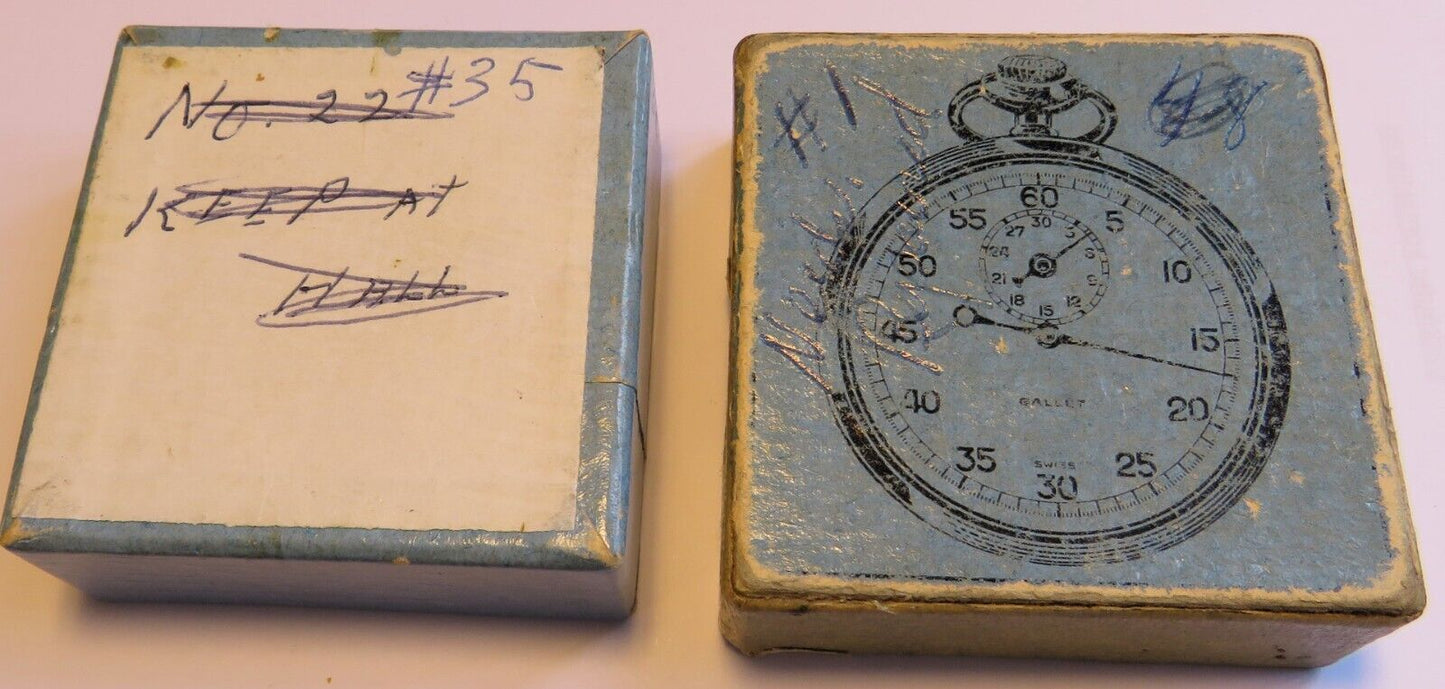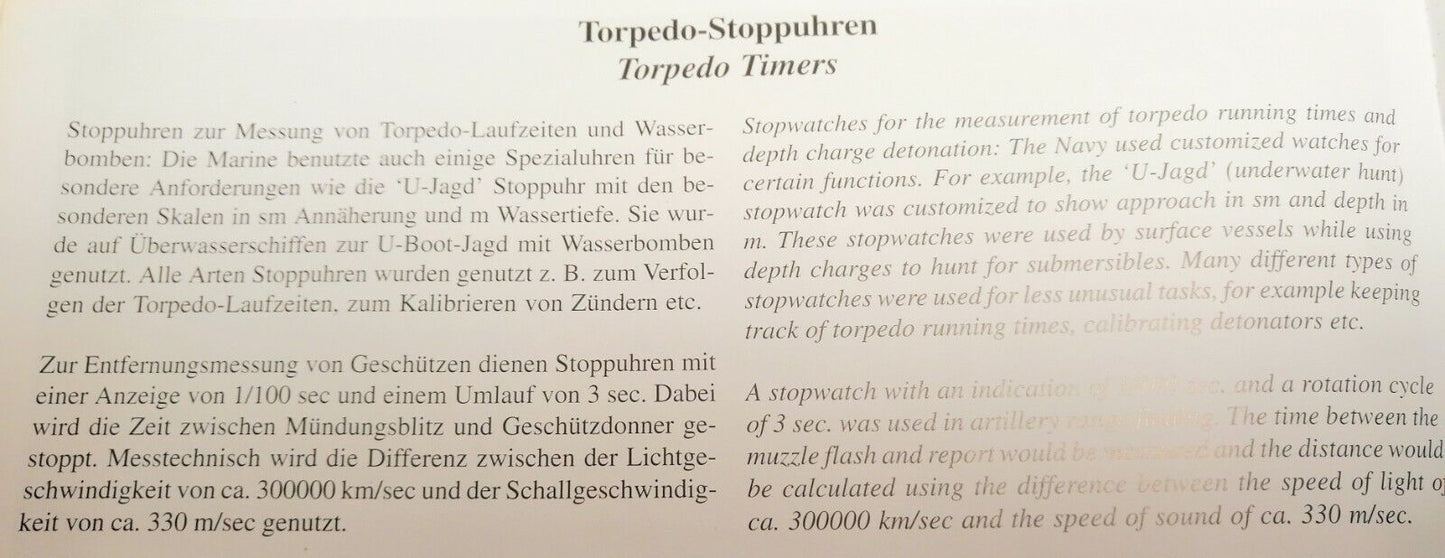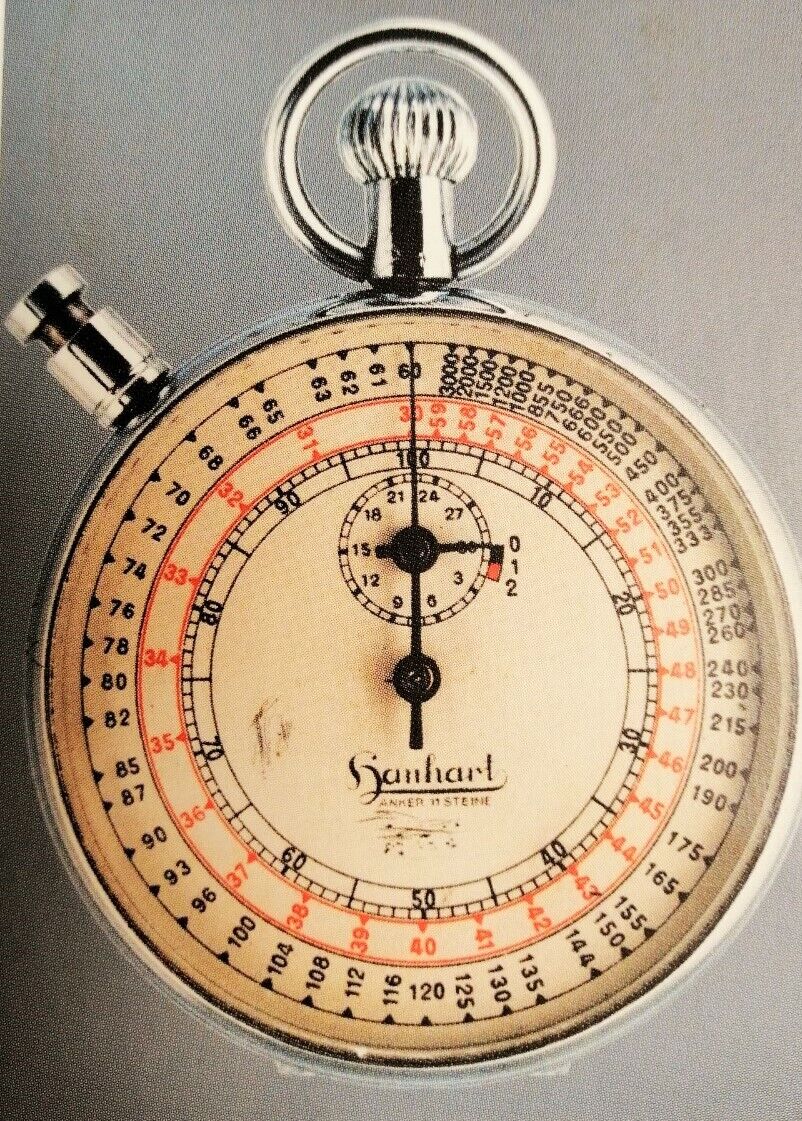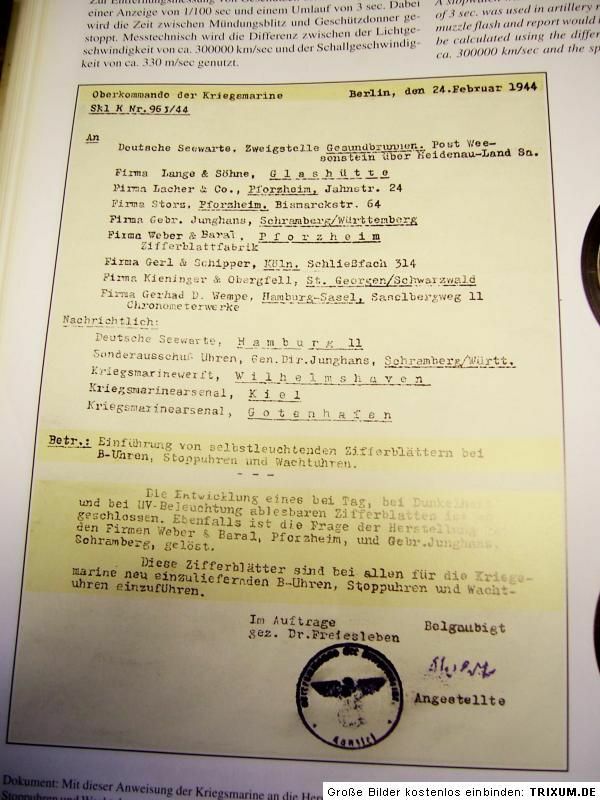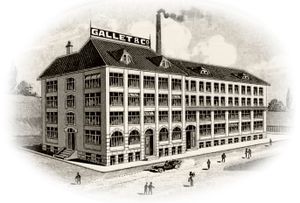Racine Gallet
Racine Gallet rare submarine torpedo running time artillery stopwatch WK WW 2 in original packaging
Racine Gallet rare submarine torpedo running time artillery stopwatch WK WW 2 in original packaging
Couldn't load pickup availability
Subject of the auction:
Orig. Racine / Gallet rare and sought-after export example of an early torpedo running time clock of the Allied forces of World War II with typical overhead indirect second and onion crown as common with the shipboard clocks of the Kriegsmarine in the late 1930s, see Knirim p. 256ff
Attention! You will receive two original Racine / Gallet stopwatches of the same model! The one described and shown in the photos plus a complete but non-functional one as a spare parts donor for the future, both delivered in the original Gallet cardboard packaging from the time.
The Swiss military and precision watch manufacturer Racine / Gallet was and is known for its extremely high-quality chronographs and stopwatches, especially before and during World War II. Since Gallet was a Swiss manufacturer, unlike Junghans, Hanhart, Kienzle, and others, this manufacturer naturally supplied not only the German Wehrmacht but also the Allied World War II opponents.
This explains the signature "IBEW" on the case back, which we cannot currently trace.
What makes this rare piece particularly rare and authentic is its dial, specially developed for submarine use, with a tachymeter scale precisely calibrated to the torpedoes, starting at 3,000 meters—the maximum distance of a submarine from the ship being attacked—then running down to 0 meters, the torpedo impact point. If no beep was heard on the torpedo travel time stopwatch after this time, the commander knew he had missed and needed to reload.
Above are a few sample photos of these very special Torpedo-running watches from Konrad Knirim's "Bible of Military Watches." It's clear that these also came from Junghans and Hanhart on the German side (the photos show a Hanhart with an identical dial/scale layout according to the Kriegsmarine's specifications).
A super rare piece of military and naval watch history, the likes of which only rarely come onto the market, and comes with original packaging and a complete spare parts dispenser!
Description:
The 100% original Torpedo running time watch, stop watch has the dimensions usual for the Navy: 50mm case diameter, white dial with top, indirect second, onion crown, side slider to start the stop function, strangely enough, this is triggered by the slider and not by the crown, which only sets to zero
Sparkling clean, double "Julius Racine" signed movement with 7 ruby bearings. Two-lid clock pressed, the lid closes absolutely flush and rock solid.
Case back signed "IBEW", "Local 1424" and "No. 4" in a way that we cannot currently trace
The stopwatch is fully functional! The signed movement is spotless, the case and crystal show barely noticeable signs of age or wear, and the unrestored dial is flawless.
EZ: 2, excellent collector's condition, barely noticeable signs of age or wear. Winds smoothly, starts and runs continuously, accuracy not tested.
History of the military and precision watch manufacturer "Gallet / Racine" (Source: WatchWiki):
Gallet & Co
Swiss watch manufacturer.
The beginning
The watch company "Gallet Genève 1466" celebrated its 550th anniversary in 2016 , as its first watchmaker, Humbertus Gallet, was verifiably born in Geneva . However, there are some questionable details, as the company Gallet & Co. was only founded in 1825 in La Chaux-de-Fonds by Julien Gallet (1806–1849). However, it was a break with tradition to name the business after the family patriarch. Previously, it was called Julien Gallet & Co. or Julien Gallet & Cie. Since 1864 , the company had been represented in New York and Chicago through its relationship with Jules Racine . In the USA, Gallet developed into a renowned watch brand. In 1914 , it created the first wrist chronograph and in 1939/1939 the legendary "Flight Officer" watch, which was worn notably by President Harry S. Truman. Jules Racine was still working as an importer of Gallet watches in 1979 .
When Julien Gallet died, Louise Gallet (1808–1865) continued the company with Léon L. Gallet (1832–1899) and Lucien F. Gallet (1834–1879) . In 1855, Léon purchased the watch factory Grumbach & Co , complete with factory and equipment, to meet the need for greater manufacturing capacity. With this expansion of workspace, Gallet was able to bring many of the Jura watchmakers together under one roof to meet Europe's growing demand for watches. Lucien established the company's first US location in Chicago in 1864, and a New York office followed shortly thereafter.
Together with Jules Racine, a cousin of the Gallet brothers living in the USA, the company began expanding into the American market. Léon Gallet's sister Amanda had married Jules Racine. The Electa brand was used for the finest watches and was controlled by Léon Gallet, some of whose production was still carried out in Geneva . On November 1, 1906 , the "Société d'horlogerie Electa" was renamed "Gallet & Co., Fabrique d'horlogerie Electa" and incorporated into Gallet & Co. Later, "Electa" was sold again to Rotherhams .
America
Due to American consumers' preference for domestically produced products, the Gallet Company created numerous new lines to accommodate this. With no watches privately labeled for established jewelry stores, Gallet introduced thirty-seven new brands. While the names appearing on the dials and the overall appearance and function of these watches were tailored to American tastes, all cases and movements continued to be produced in Gallet's La Chaux-Fonds workshop.
Each of the numerous brands was aimed at a different target audience. Low-priced watches were supplied to the average working man, as well as expensive, high-quality and complicated watches in solid gold cases for the wealthy. Gallet's finest pocket watches, handcrafted in the classic Swiss tradition and retaining the family flagship and the Electa name, were always available.
Although initially unsuccessful, the world's first mass-market wristwatches were introduced to the American market in 1895. By the end of the 19th century, the Gallet family was producing and selling over 100,000 watches per year.
In 1883 , Henriette Gallet (1860-1939) , daughter of Léon Gallet, married Émile Courvoisier (1858-1937) . Brother Georges L. Gallet (1865-1946) married Berthe Courvoisier (1868-1936) , a sister of Émile. The working relationship between these two important watchmakers in La Chaux-de-Fonds became familial. In 1883, Léon retired from the company, and Gallet's sons, Julien Gallet (2) (1862-1934) and Georges L. Gallet, took over the business, with Georges also being involved in the company Courvoisier & Cie . He also controlled the Electa workshops.
Another important partner was Albert Jeanneret's company, later known as Excelsior Park , as a supplier of chronograph movements and stopwatches . From 1896 onward, railway pocket watches with chronometer movements and patented fine adjustment were manufactured by Gallet under the brand name Interocean and distributed by Timothy Eaton (T. Eaton Department Store) for railway use in America.
That same year, Gallet won a silver medal at the Swiss National Exhibition in Geneva. Webster Clay Ball 's Ball Watch Company also purchased railway clocks from Gallet.
During a visit to New York in 1899 , Léon Gallet died at the age of 67. His brother Lucien had already died in 1879. The Gallet family had become very wealthy; upon Léon's death, he bequeathed 43,000 francs to the town of La Chaux-de-Fonds, of which 18,000 francs were donated and 25,000 francs were earmarked for a new museum. He was well aware of Maurice Picard 's idea of creating a watch museum, the Musée International d'Horlogerie .
Gallet donated over 100 highly complex and valuable Gallet, Electa, and Courvoisier watches. Georges Gallet served as director of the museum for the next twenty years. In 1905, Gallet & Co. received an honorary diploma at the International Exposition in Liège.
First World War
In 1914, Gallet won the grand prize in the chronometer category at the Swiss National Exhibition in Bern. Production began in Gallet's Electa workshops with a particularly high-end watch series for wealthy clients of the Laforge & Valentine jewelry department of Macy's New York store. All watches, produced under the name "Lifetime Series," featured between 21 and 23 jewels , a bimetallic temperature-compensated balance , a Breguet hairspring , and chronometer accuracy in six positions.
However, World War I forced Gallet to produce less luxurious watches, as the company supplied hand-held and cockpit timers for the British Air Force during World War I. The movements were produced in Gallet's Electa workshop and marked with the Electa name. Gallet supplied wrist-worn chronographs to the British armed forces during World War I.
This early chronograph wristwatch was clearly a transitional timepiece. While technically refined and reduced in size from a traditional chronograph, it still retains the three-piece case, porcelain enamel dial, and center button crown of its larger predecessor.
In 1917, Gallet won first place for chronometer accuracy at the Cantonal Observatory in Neuchâtel. The Elekta brand was acquired by Rotherhams in 1927 .
1918-1939
Henri Jeanneret-Brehm begins production under the company name Excelsior Park . The English variant of the French word for "park," derived from Jeanneret-Brehm's earlier brand, "Excelsior," is used at Gallet's suggestion to support the two companies' collaboration in marketing to the American consumer. The cooperative relationship between Excelsior Park and Gallet leads to the development of a series of timekeeping mechanisms, including the Caliber 40. These new chronograph movements are used almost exclusively in Gallet and Excelsior Park wristwatches, with a small number in Girard-Perregaux and Zenith , as production allows.
In 1927, Galle was one of the first companies to introduce the "Regulator" and "Duo Dial" wristwatches for medical and technical applications. The rectangular "Duo Dial" model's large lower second scale and the predominant reset second hand simplified the calculation of a person's heart rate per minute. The "Duo Dial" was also offered by other companies such as Rolex , Gruen , Longines , Alpina , Bulova , and Hamilton .
When the global economic downturn of the 1930s caused international trade to collapse by as much as two-thirds, it suddenly became unprofitable for the Gallet Company to continue producing many of its recently established brands.
Gallet instead decided to refocus his efforts on his primary area of expertise, the production of high-quality professional timepieces.
As World War II loomed around 1935 , Gallet began producing wristwatches, boat clocks with 8-day movements, and military stopwatches for Great Britain, Canada, and the United States.
One year later, Gallet introduced the first waterproof cases to protect the delicate mechanism of chronograph wristwatches from the damaging effects of moisture. This innovation became standard on many models of Gallet's "MultiChron" line for professional use, as well as on the Flieger military pilot's watch. Commissioned by Senator Harry S. Truman, a staff member for the US Army Air Force pilots, Gallet created the Flight Officer Chronograph in 1938 .
This wristwatch offers a combination of innovations. In addition to being able to accurately record events lasting from 1/5 of a second to 30 minutes, the rotating 12-hour bezel and dial (dial) printed with major cities give pilots the ability to calculate changes in time as longitude crosses. Truman wore a Gallet Flying Officer's Watch during his two terms as U.S. President.
One year later, the company produced the "Multichron Petite." The Petite was one of the first wrist chronographs developed exclusively for women serving in technical and scientific roles during World War II. Powered by the 10-line Valjoux 69 movement and measuring just 26.6 mm in diameter, the MultiChron Petite was the smallest mechanical chronograph ever produced.
|
History of military wristwatches: The history of the military wristwatch began in the last third of the 19th century. During the American Civil War (1861–1865), pocket watches were used exclusively, and even then only by officers who could afford such technical achievements. At this time, there were already the first "real" wristwatches for women from various manufacturers, but these were neither accurate nor robust enough for military purposes and were perceived at that time as a mere fashion gag and trend. The disadvantages of a pocket watch in the field or in combat are obvious: it took 10 seconds or more to pull it out of the pocket of the tight, thick uniform jacket. This time—extremely long in combat—could, in the worst case, result in a bullet hit and wound, because one would be distracted from the action and preoccupied with the pocket watch during the crucial seconds. Soldiers of various armies therefore increasingly began to insert pocket watches into self-made leather straps with sewn-on hollow flaps so that they could be worn on the wrist and used at any time. It is considered certain that a well-known Swiss manufacturer was the first manufacturer to win a tender among Swiss watch manufacturers around 1880 and supplied the German Imperial Navy with pocket watches combined with such bracelets, which were initially used in naval attacks and naval battles with several ships to synchronize the guns and salvos. In the Second South African Boer War (1899-1902), these "leather cuff wristwatches/pocket watches" made a decisive contribution to the victory of the technically superior British, along with other military innovations such as smokeless gunpowder, the multi-shot magazine for assault rifles, and the first prototypes of machine guns. The first known "test report" of these wristwatch models dates from this period: on June 7, 1900, a captain of the Northern Staff Regiment in the Boer War reported to his superiors: "I wore this "wristwatch" directly on my wrist for 3.5 months during my service at the front in South Africa. It kept excellent time and never let me down." It is documented that the early Imperial Air Force, even during World War I (1914–1918), equipped its legendary fighter squadrons with these models as standard equipment. The now industrially manufactured hollow leather cuffs were stamped on the back with the initials of the pilots or officers who owned them and the identification number of the respective fighter squadron. Several photographs of Kaiser Wilhelm II from the period before 1918 also survive, showing him proudly wearing this earliest of all military wristwatch models with his uniform. Another decisive step was the invention in 1906 of an interchangeable and variable-length leather strap (for pilots to wear on the thigh over their flight suit) with soldered bars or wire loops, which allowed the threading of thin leather loops. This was the first so-called "under-the-belt strap," some of which are still used today by the military or by divers. A major problem was the crystal glass used at the time, which was extremely fragile and prone to impacts and shattering, especially in direct combat. This was initially remedied around 1910 by simple cover plates with large holes (later metal mesh, called "shrapnel protection") to make the dial easier to see. There is a misconception that these grilles on the so-called "trench watches" were designed to protect against grenade splinters. This is, of course, nonsense! Neither a wristwatch nor a pocket watch, nor any grille in front of them, could withstand a grenade splinter. The protective grilles served as protection against mechanical forces and impacts during front-line work, such as digging, carrying heavy beams during entrenchment, or operating, loading, and unloading artillery pieces with heavy shells. These early guards and grilles were initially self-made or were made by completely unrelated craftsmen such as blacksmiths or ironmongers and sold individually to the existing clock and, if necessary, also adjusted in size: The legendary "Trench Clock" was born. The trench watch quickly became a status symbol of war heroes and front-line soldiers due to its unique and eye-catching design and was worn and presented with pride long after the war. This upgrading to a status symbol similar to an order, from the simple soldier to the highest officer, also explains why these trench clocks were produced long after the First World War, were elaborately and artistically designed and the lids were mostly made of silver, even though this metal was far too soft for use on the front lines. The technical term for these trench watches was internationally established as "Half Hunter" (because only part of the dial was visible) or simply "Trench Watch". Despite their military suitability and proven performance in front-line operations, these early military watches were not yet "true" military wristwatches, but were based entirely on ladies' pocket watches or their movements. These early models did not yet make the leap to the civilian, "primary market" and remained reserved for the military for almost two decades. The main supplier of these pilot's pocket watches before and until the end of the First World War was a Berlin manufacturer. This standard pilot's watch of the early Reichsluftwaffe was always signed "Property of the Air Force" on the dial and featured the Air Force's logo on the caseback: a propeller with two lateral blades. The second major supplier of this watch type was the George Ducommun manufactory. The most striking feature of both models was the rotated dial, with the crown at the bottom and the indirect second hand at the top of the actual "12." With the outbreak of the First World War, the importance and demand for robust and precise wristwatches changed rapidly! While the Imperial Army was still equipped with simple pocket watches in leather cuffs, which were worn on long straps over the flight suit or hung in the leather cuffs clearly visible in the cockpit, the Allied armies – encouraged by the positive experiences from the Anglo-Dutch Boer War in South Africa – were equipped with a wide range of small military pocket watches with interchangeable, fixed straps on fixed, soldered bars. These small pocket watches were already upgraded by the manufacturer for military use, some of them already had radium-filled, self-luminous hands and the "shrapnel protection grid" factory-fitted, often even with a convenient folding hinge or for removal This type of first genuine military wristwatch was given "warlike" fantasy names by the manufacturers such as "Mars" (from the Greek god of war Mars), Bellum, in further variations also Rellum, "Hindenburg" or in allusion to the newly developed submarine weapon "U 29", "U21" etc. In addition, other features for military use, such as a small compass embedded in the case, were developed and installed. In Germany, these models were offered around 1950 at a price of 17 Reichsmarks (simple versions) to 37 Reichsmarks (for models with second hand). They were professionally distributed and advertised on the civilian market, for example, by the companies "Siemann Army and Marine Watches" in Berlin, "Oswald Staerker" in Pforzheim, the "Germany Watch Manufactory Leo Frank", but also by the small manufactories from Munich, Pforzheim and Glashütte, which later became very important. In 1914, global demand for military wristwatches reached its first peak. Wristwatches were no longer a novelty or a "gimmick," but a vital piece of war equipment. From around 1912, manufacturers could barely keep up with the production of genuine military watches. The company that profited the most from this was Wilsdorf&Davis Ltd., founded in London in 1915. Later, under the name best known for luxury watches, it became an internationally renowned luxury watch manufacturer. In the early years, W&D initially only built purchased movements (e.g., from the later acquired Rehberg company) in cases that were also purchased, e.g., from Dennisson. Hans Wilsdorf, the founder and director of W&D, was the first strong advocate of wristwatches since the turn of the century. While others still scoffed at this new trend, Wilsdorf had already been experimenting with their precision, reliability, and accuracy for years. It is said that the German Hans Wilsdorf contributed more to the development of the wristwatch we know today than anyone else in his field. Wilsdorf subjected his wristwatch movements to the most stringent inspections and stress tests. He was also the one who came up with the idea of regularly sending his new developments to the Neuchâtel Observatory (Switzerland) for further testing. He can therefore be considered the inventor of the chronometer, or rather, the chronometer test, which the world's best and highest-quality watch manufacturers and models still voluntarily undergo today. W&D received the first wristwatch chronometer awards from the School of Watchmaking in Biel (1910), and the Class "A" Certificate of Precision from the Kew Observatory in England (1914). To date, W&D has more certificates from the Contrôle Officiel Suisse des Chronomètres (COSC) than all other watch manufacturers in the world combined. Even during the First World War, other manufacturers such as Franz Baumgartner, Borgel or Dennison recognized or suspected the impending triumph of the new wristwatch and contributed to the development of ever better cases that were more resistant to splinters, shocks, dust or water. Further developments in the post-war period were the invention of solid, fixed metal bars to better protect the solid bezel around the case, glass and movement, as well as the indirect second with sub-dial as a precursor to the later and still common "central second" However, the development and presentation of the first truly waterproof wristwatch was reserved for W&D in 1926 with its wristwatch, which is still successful today and is called "Oyster". The next milestone in the military wristwatch is the early Swiss military watches with arrow index from 1928 – 1930 As a precursor to the chronograph with second hand and zero setting, which was known from 1932 onwards – especially for Luftwaffe pilots to calculate flight time, fuel consumption or supply, etc. – an unknown inventor and watchmaker invented and developed a rotating bezel with an applied arrow index around 1926. This original solution for pilots and flight personnel is not comparable to the diverse possibilities of a column wheel chronograph, but by setting the index arrow with the rotating bezel either to the time of departure or to the time until the maximum fuel limit, one has more or less precise and easily accessible information at any time, without having to pick up and use additional instruments or make separate notes. Other typical features of these models were extremely wide, curved lugs and the fact that they were almost never signed with national emblems, because an air force was not allowed in Germany in the 1920s according to the Treaty of Versailles and for this reason was not allowed to act as such and issue signed equipment. In fact, within 2 years, absolutely all known manufacturers in Germany and Switzerland produced these early pilot watches with rotating knurled bezel and arrow indexing for exclusively military use. Responsible for the development and procurement of this equipment was the legendary flying ace of the young Reichsluftwaffe (which existed and operated years before its official founding, contrary to the Treaty of Versailles), Ernst Udet, who was entrusted with this important task by his old flying comrade from the Jasta (fighter squadrons of the imperial air force) during the First World War and later Reich Minister of Aviation, Herman Göring. It is unknown who invented this type of watch or which manufacturer first produced it. In the mid-1930s, this early pilot's watch of the Reich Air Force was gradually replaced by genuine chronographs, which had since been invented, and the legendary B-watches with diameters up to 60mm, which were worn over pilot's uniforms. Starting in 1935, infantry and ground personnel received so-called "Wehrmacht Service Watches," which were produced and delivered by all manufacturers. These quasi-standard military watches were usually 35 cm in diameter, featured an indirect second hand, radium-filled hands and indices, and often also anti-magnetic soft iron protection for the movement. These Wehrmacht service watches were often signed with an abbreviation for the associated branch of service or Wehrmacht division, e.g., the letters "D" and "H" for "Deutsches Heer," "RLM" for Reichsluftfahrtministerium (Reich Air Ministry), "DAK" for "Deutsches Afrika Korps" (German Africa Corps), or even just a "D" for Deutschland (Germany). Copyright 2010: Reiner Haas History of the pilot watches of the Reichsluftwaffe: On January 30, 1933, Hermann Göring was appointed Reich Commissioner for Aviation, and on May 10, 1933, the "Reich Air Ministry" was founded. On May 1, 1933, approximately 550 aviation officers were transferred from the Army and Navy and formed the core of a third branch of the armed forces. The first armament program of 1933 envisioned an air fleet of approximately 600 aircraft, with a focus on bomber squadrons. In March 1935, Reich Defense Minister Blomberg ordered the gradual unmasking of the Luftwaffe, which until then had been built up in secrecy due to the prohibition of the Treaty of Versailles. From the very beginning, robust and highly precise pilot's watches played a major role in the equipment of young fighter pilots. At the beginning of the 1930s, two factors played a key role in the selection and quality of pilot's watches: First, the wrist chronograph, which would later become common in World War II, had just been invented, and second, the existence of an Imperial Air Force was not permitted under the Treaty of Versailles. For this reason, the early and indeed very first pilot's watches were not signed or marked with any Reich Air Force symbols. This first generation of pilot watches of the Reichsluftwaffe were almost identical in dimensions, construction and function: With a 40mm case diameter—the later size of the legendary Wehrmacht chronographs—slightly larger than "normal" service watches, they were generally equipped with a rotating, knurled bezel and index markers due to the lack of chronograph functions for precise measurement and display of flight duration. Wide, curved lugs and lugs, which extended far back to the rear, which became a distinguishing feature of these early pilot's watches, allowed them to be worn on a long strap over the pilot's overalls. All models of this period already possessed the typical features that later became standard for all Wehrmacht service watches: indirect second hand at the "6," a black dial, radium-filled hands, and Arabic numerals. Early pilot's watches with arrow indexes, all issued unmarked, were produced by virtually all renowned brands and supplied to the Reich Air Force. Given that the air corps and squadrons of the Imperial Air Force initially numbered only a few hundred pilots (although these models were also used by the thousands of Reich Air Force crews), these rare early pilot's watches were only produced in very small numbers and therefore today achieve similar prices at specialist auctions to the technically much more complex legendary B-watches and Wehrmacht chronographs, which were later produced in significantly larger numbers. In the mid-1930s, major watch manufacturers developed and, from 1938 onward, produced genuine pilot's chronographs and so-called B-Uhren (observation watches), which represented the absolute state of the art of watchmaking and technology at the time. Both versions of high-precision, military watchmaking had a significantly larger diameter of approximately 40mm to 60mm (B-Uhr) compared to the so-called "service watches for the army and Wehrmacht." Until shortly before the end of the war, these legendary, rare, and coveted pilot's watches were signed by the now officially established Reich Air Force with "RLM," "Reich Air Ministry," and often additionally engraved with "NAV B Uhr." However, starting in 1944, in the hustle and bustle of the looming loss of the World War, unsigned models were also issued to the air force. B-Uhren were produced at various locations; for example, the dials were manufactured centrally and delivered by the Wehrmacht. In some cases, existing movements (e.g., from Durowe) were also used. There were two versions of the legendary B-Uhren dial: initially, from 1939, the version without an inner hour circle and with a triangle and two dots instead of the "12." From 1943, the version with an inner hour circle without a triangle was introduced (for this version, the hour hand was made smaller). The reason for this was that it was discovered that the Luftwaffe primarily flew short missions, and for this reason, the indication and legibility of the minutes was significantly more important than that of the hours. From 1943 onward, only the new dials with a large minute circle were used, and every time an older model was sent in for maintenance or repair, the dial was replaced at the same time. The older, larger hour hand was usually left on the clock because there weren't enough new, smaller hour hands available. For this reason, a large number of B-clocks with an inner hour circle and large hour hands still exist today. These examples are not "cobbled together," but rather represent a completely authentic piece of military clock history: originally built with a large hour circle and triangle, they were damaged in combat (e.g., a pilot crash or a grenade splinter impact). They were then repaired, the new dial was installed, and the old hour hand was retained due to a lack of spare parts. The legendary level of fame and - in comparison to the number of active fighter pilots - the high numbers of these magnificent pieces that were produced can be explained by the fact that the B-Uhren and Fliegerchronographs were naturally desired, bought, worn and shown off as the latest state of the art and also as a status symbol by the officer corps and the general staff up to the highest army command, the heads and grandees of the Third Reich. With the introduction of the above-mentioned pilot's watches, the High Command of the Air Force, which was rearming with all its might for the impending World War, made a distinction between pilots and crew members when issuing pilot's watches. While in the early 1930s pilots, flight crews and ground crews received and wore the same watches, the B-watches and chronographs were issued exclusively to pilots and bomb gunners, while the crews and flight crews received smaller, much less elaborate service watches similar to those worn by the Herr and other combat units. Since the generally recognized Wehrmacht signature "DH" is clearly assigned to the "Heer Dienstuhren" (Army Service Watches), it is now assumed that the signature "D" was intended for all Luftwaffe service watches. Thus, from approximately 1936 to 1944, Luftwaffe service wristwatches were marked either with "D," "RLM," or both. Before 1936 and from 1944 onward, they were also issued unsigned for the reasons already mentioned. The calibers used were the "space-saving wonders" UROFA 85, 58 and 581, which were specially developed for mass production as part of the Luftwaffe's rearmament in the mid/late 1930s, the so-called "Wehrmacht caliber" AS 1130 by Anton Schild, as well as the PUW (Pforzheimer Uhrenwerke) calibers 300 and 500, which were delivered centrally to the manufactories, but also the respective manufacturers' own movements. For collectors and enthusiasts of Wehrmacht watches, Luftwaffe pilot watches are a special treat because they were produced in significantly smaller numbers than the army and were sometimes much more robust and elaborately crafted, as well as having special additional functions such as a rotating bezel with indexing, a screwed stainless steel back, shock protection, or additional anti-magnetic soft iron protection. Especially the very early and rare pilot watches with arrow index often achieve prices at specialist auctions on a par with the legendary B-Uhren and Wehrmacht chronographs. Copyright 2007: Reiner Haas An offer from the sole proprietorship Reiner Haas, Managing Director is Reiner Haas
|
